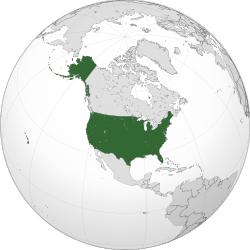United States of America | |
|---|---|
| Motto: "In God We Trust" Other traditional mottos:
| |
| Anthem: "The Star-Spangled Banner" | |
| Capital | Washington, D.C. 38°53′N 77°1′W / 38.883°N 77.017°W |
| Largest city | New York City 40°43′N 74°0′W / 40.717°N 74.000°W |
| Official languages | None at the federal level |
| National language | English |
| Ethnic groups (2020) | By race:
By origin:
|
| Religion (2023) |
|
| Demonym(s) | American |
| Government | Federal presidential republic |
| Donald Trump | |
| JD Vance | |
| Mike Johnson | |
| John Roberts | |
| Legislature | Congress |
| Senate | |
| House of Representatives | |
| Independence from Great Britain | |
| July 4, 1776 | |
| March 1, 1781 | |
| September 3, 1783 | |
| June 21, 1788 | |
| Area | |
Total area | 3,796,742 sq mi (9,833,520 km2) (3rd) |
Water (%) | 7.0 (2010) |
Land area | 3,531,905 sq mi (9,147,590 km2) (3rd) |
| Population | |
2024 estimate | |
2020 census | |
Density | 87/sq mi (33.6/km2) (185th) |
| GDP (PPP) | 2024 estimate |
Total | |
Per capita | |
| GDP (nominal) | 2024 estimate |
Total | |
Per capita | |
| Gini (2023) | medium inequality |
| HDI (2022) | very high (20th) |
| Currency | U.S. dollar ($) (USD) |
| Time zone | UTC−4 to −12, +10, +11 |
Summer (DST) | UTC−4 to −10 |
| Date format | mm/dd/yyyy |
| Calling code | +1 |
| ISO 3166 code | US |
| Internet TLD | .us |
Table of Contents
Introduction to Trademark Law in the Digital Era
In the United States, trademark law serves as a crucial mechanism for protecting brand identity and ensuring consumer trust. A trademark, which can be a word, phrase, symbol, or design, distinguishes the goods or services of one entity from those of others. This legal framework not only safeguards the interests of businesses but also empowers consumers to make informed choices by identifying the source of products. However, the rapid evolution of digital platforms has significantly impacted traditional trademark practices, requiring adaptations to accommodate the complexities of a virtual marketplace.
As businesses increasingly engage with consumers through online channels, the importance of robust trademark protections becomes evident. Digital assets, such as websites, social media profiles, and e-commerce platforms, have transformed the way brands interact with their audiences. This shift has necessitated a re-examination of existing trademark regulations, as brands must now protect their intellectual property across multiple digital realms. The rise of online marketing strategies, digital advertising, and virtual branding introduces new challenges, such as the risk of dilution and infringement, which demand vigilant enforcement of trademark rights.
Moreover, the integration of virtual trademarks, or trademarks used within digital environments such as video games and social media, has introduced an entirely new layer of complexity. Businesses must navigate the potential for confusion among consumers in these immersive settings, requiring a comprehensive understanding of digital trademark law. As companies adapt to these changes, the implications for both businesses and consumers are profound, affecting everything from brand loyalty to the overall integrity of the marketplace. This evolving landscape of trademark law in the digital era underscores the ongoing need for legal frameworks that effectively protect intellectual property while fostering innovation and competition.
The Rise of Digital Assets and Virtual Trademarks
In recent years, the concept of digital assets has undergone a significant transformation, particularly with the advent of non-fungible tokens (NFTs). These unique digital items are stored on blockchain technology, allowing for verifiable ownership and provenance, making them unlike any other kind of asset. As a result, the popularity of NFTs has given rise to new opportunities for trademarks in the digital environment. Virtual trademarks are emerging as crucial components of a brand’s identity in online spaces, particularly within platforms such as the metaverse, a digital universe where users can interact in real time.
Unlike traditional trademarks, which primarily serve to identify the source of goods or services in the physical world, virtual trademarks operate in a more complex digital landscape. They encompass elements like logos, usernames, and avatars that exist within online platforms and games. Consequently, the enforcement and protection of these virtual trademarks present unique challenges as businesses navigate the intricacies of trademark law in a constantly evolving digital ecosystem.
Brands are increasingly recognizing the importance of securing virtual trademarks to maintain their presence in digital spaces. The protection of these digital assets is critical, as the proliferation of counterfeits and unauthorized usage in virtual environments threatens the integrity of established brands. Moreover, virtual trademarks can foster brand loyalty and engagement by creating immersive experiences for users in the metaverse, thereby enhancing commercial opportunities. As companies adapt to this growing trend, the legal landscape surrounding trademarks will continue to evolve, necessitating a deeper understanding of the implications and protections offered by trademark law in the realm of digital assets.
Legal Framework for Protecting Virtual Trademarks
The legal landscape concerning virtual trademarks and digital assets is evolving rapidly to accommodate the advancements in technology and commerce. Traditionally, trademarks have been protected under the Lanham Act, which encompasses symbols, names, and devices that distinguish goods and services. This act is fundamental in providing a framework for trademark registration and enforcement, fulfilling its role of preventing consumer confusion and protecting brand reputation.
In the digital age, however, the enforcement and registration of virtual trademarks present unique challenges. The rise of virtual assets, such as non-fungible tokens (NFTs), digital goods, and mobile applications, necessitates an expansion of existing legal parameters. The United States Patent and Trademark Office (USPTO) has begun to acknowledge these developments by accepting applications that encompass virtual goods and services. Recently, the USPTO has released guidelines illustrating how businesses can seek trademark protection for their digital assets. Such measures enhance the visibility and security of virtual trademarks.
Relevantly, recent case law has illustrated the courts’ willingness to adapt traditional trademark principles to address disputes involving virtual trademarks. For instance, litigation surrounding unauthorized use of digital assets highlights the importance of maintaining distinctiveness and preventing dilution. Courts have determined that virtual trademarks can carry the same weight as traditional trademarks regarding injury and confusion claims. As such, businesses venturing into the digital sphere must remain vigilant and proactive in securing their intellectual property rights.
Moreover, it is imperative for companies to closely monitor their virtual branding efforts in order to enforce their trademarks effectively. Collaboration with legal experts specializing in both trademark law and digital assets can aid in navigating the complexities of this new landscape. Consequently, as more businesses adopt digital strategies, understanding the current legal framework becomes crucial to safeguard their virtual trademarks in an increasingly interconnected world.
Challenges in Trademark Registration for Digital Assets
As businesses increasingly venture into the digital realm, the challenges associated with trademark registration for digital assets have become paramount. One of the primary concerns is the distinctiveness of digital trademarks. In traditional domains, a trademark must be inherently distinctive or have acquired distinctiveness through use in commerce. However, with the rise of virtual goods, it can be difficult to establish the uniqueness of symbols, words, or designs, especially when they are similar to existing trademarks. This challenge is exacerbated by the rapid evolution of digital landscapes, where trends can emerge and dissipate swiftly, complicating the definition of what constitutes a distinctive mark.
Another significant issue is the likelihood of confusion among consumers, particularly in the context of the internet where the lines between various types of goods and services can blur. For instance, a digital asset branded with a common term may cause confusion with similar marks, undermining the brand’s identity. Companies must therefore conduct thorough searches to assess potential conflicts and determine if their intended trademarks could infringe upon existing rights. This process necessitates not only an understanding of trademark law but also an acute awareness of market positioning and consumer perception within digital environments.
Adjustments in trademark classification are required to keep pace with the emergence of new digital goods and services. The current trademark classification system, established long before the advent of digital assets, often fails to adequately categorize new offerings such as software applications, virtual goods, and online services. As a result, businesses may find themselves struggling to identify the appropriate class under which to file their trademarks. This lack of clarity can lead to increased uncertainties and slow down the registration process. Therefore, as digital assets continue to proliferate, there is an urgent need for a reevaluation of the trademark classification system to better accommodate these modern innovations.
International Perspectives on Trademark Law Beyond the U.S.
As digital assets and virtual trademarks continue to proliferate, understanding international trademark law becomes increasingly essential for businesses operating in the global marketplace. Different jurisdictions adopt varying approaches to trademark protection, particularly in the context of the digital economy. While the United States often emphasizes a use-based system of trademark registration, many other countries adopt different strategies that can impact international business operations.
For instance, the European Union operates under a comprehensive framework known as the European Union Trademark (EUTM) system. This system allows for streamlined registration across all member states, thus fostering a more uniform approach to trademark protections. Additionally, the European Union’s emphasis on the principle of “first-to-file” can contrast sharply with the U.S. approach, which allows for some leeway to claim rights based on usage. This distinction can lead to conflicting outcomes when businesses engage in international expansion, as a trademark secured in the U.S. may not afford the same protections in Europe without proper registration.
In contrast, countries such as Japan and China have established their own unique perspectives on trademark law, influenced by local market dynamics and legal frameworks. China’s enforcement measures for virtual trademarks are particularly noted for being stringent, reflecting the country’s broader strategy to address counterfeit goods and online infringement. Furthermore, the introduction of digital assets like Non-Fungible Tokens (NFTs) has raised complex questions regarding the ownership and protection of trademarks in these digital formats, which international jurisdictions are still in the process of defining.
The necessity for multinational corporations and entrepreneurs to grasp these varied international trademark laws cannot be overstated. Having an in-depth understanding of the international landscape regarding digital assets and virtual trademarks not only aids in compliant operations but also provides a competitive edge in today’s ever-evolving global market.
Impact of Social Media and Influencer Marketing
The advent of social media and the rise of influencer marketing have significantly impacted trademark rights and protections in the United States. As brands increasingly leverage digital platforms to connect with their audiences, the speed at which trademarks can spread in digital environments poses both opportunities and challenges. The incorporation of trademarks in social media campaigns often involves partnerships with influencers who have the ability to reach vast numbers of potential consumers. This phenomenon raises essential questions about trademark enforcement and brand identity in rapidly evolving digital landscapes.
Influencer marketing campaigns frequently entail collaborations that blur the lines between personal branding and commercial endorsement. These relationships necessitate careful consideration of trademark usage, as brands risk diluting their trademarks or inadvertently allowing unauthorized usage by influencers and their followers. The legal implications of user-generated content on social media are particularly complex; content created by consumers can inadvertently infringe on trademark rights, leading to potential disputes between brands and users over usage rights and attribution.
The implications of social media extend to the potential for brand reputation damage, as negative consumer feedback shared in digital spaces can impact a brand’s image and trademark value. Furthermore, the nature of instantaneous sharing in social media can result in the rapid dissemination of trademarked material, complicating traditional trademark protections. In this context, owners of trademarks must be vigilant, monitoring social media platforms for misuse and asserting their rights proactively to maintain brand integrity.
Ultimately, the intersection of trademark law and digital marketing requires brands to be informed and strategic in their approach. Understanding the nuances of social media usage and influencer collaborations is critical to safeguarding trademarks in this fast-paced digital era.
Recent Case Studies and Precedents
In the dynamic landscape of trademark law in the United States, recent case studies have illuminated how courts are grappling with the challenges posed by digital assets and virtual trademarks. One significant case is Mattel, Inc. v. MCA Records, Inc., where the Ninth Circuit examined the intersection of trademark rights and creative expression in a digital context. The court ruled in favor of MCA Records, emphasizing the importance of artistic interpretation over strict trademark protection. This ruling underscored the nuanced relationship between trademarks and digital media, setting a precedent for future cases involving intellectual property in the entertainment sector.
Another pivotal case is In re Tam, which brought attention to the question of disparagement in trademark registrations. The Supreme Court determined that the disparagement provision of the Lanham Act was unconstitutional, thereby allowing the trademark for the band “The Slants” to be registered. This decision has broad implications, not only for traditional trademarks but also for virtual trademarks, as it encourages the registration of potentially controversial marks within digital realms.
Furthermore, the Facebook, Inc. v. Duguid case illustrated the evolving interpretation of use in commerce related to digital communication tools. The Ninth Circuit ruled that the definition of an “automatic telephone dialing system” under the Telephone Consumer Protection Act does not extend to the technology used by Facebook to send text messages. This case is instrumental in clarifying how digital technologies intersect with trademark laws and privacy rights, particularly in advertising and marketing contexts.
Collectively, these case studies reflect a trend in U.S. trademark law that favors adaptability in light of technological advancements. As courts continue to interpret existing laws, the implications for digital assets and virtual trademarks will be profound, necessitating close attention from legal professionals and businesses alike.
Future of Trademark Law: Predictions and Trends
The landscape of trademark law is poised for significant evolution as we advance into an era dominated by digital assets and virtual trademarks. Predictions suggest that legislative reform will play a crucial role in adapting trademark protections to meet the challenges posed by the digital economy. As the use of non-fungible tokens (NFTs) and virtual goods becomes increasingly prevalent, legislative bodies may respond by establishing clearer frameworks to regulate these emerging forms of intellectual property. This could lead to new statutes specifically tailored to address the unique aspects of digital branding and trademark registration processes.
In addition to legislative changes, the patterns of consumer behavior are expected to shift, which will further influence the future of trademark law. Consumers are increasingly relying on digital platforms for purchasing goods and services, which necessitates a re-evaluation of traditional brand recognition and trademark enforcement strategies. There is likely to be a growing need for trademark owners to understand and engage with their audience in the digital realm, particularly in virtual environments like metaverses, where conventional branding tactics may not suffice.
Moreover, technological advancements will undoubtedly affect trademark protections. Innovations in artificial intelligence (AI) and machine learning are likely to streamline the trademark registration process, enabling more efficient searches and conflict resolutions. These technologies may also assist in monitoring the use of trademarks online, offering trademark owners proactive tools to combat infringement in real-time. This can create a more dynamic environment for trademark law, where adaptability and prompt responses to new challenges are essential.
As we look forward, the convergence of legislative change, evolving consumer habits, and technological progress will collectively shape the future of trademark law. Stakeholders, including legal professionals and brand owners, must remain vigilant and proactive in navigating this transforming landscape to safeguard their intellectual property. In conclusion, the fusion of these factors will provide both opportunities and challenges, necessitating a forward-thinking approach to trademark law in the digital age.
Conclusion: Adapting to a New Trademark Landscape
The rapidly evolving landscape of trademark law in the United States presents both challenges and opportunities for businesses and legal practitioners. As digital assets and virtual trademarks gain significance in the marketplace, understanding these emerging trends is crucial for effective trademark protection. Businesses must recognize the importance of adapting their trademark strategies to navigate a digital environment that is continuously changing.
Firstly, the rise of digital commerce and social media has transformed traditional approaches to trademark registration and enforcement. Companies are increasingly required to secure their intellectual property in online marketplaces where user-generated content can blur the lines of ownership. Consequently, organizations must actively monitor their brand presence across various digital platforms to ensure their trademarks are not infringed upon or diluted. Legal practitioners, therefore, must remain current on precedents that shape the landscape of digital trademarks and be prepared to provide strategic advice tailored to their clients’ operational realities.
Secondly, the introduction of non-fungible tokens (NFTs) and virtual goods necessitates new considerations around trademark protection. Businesses venturing into this space must evaluate how their existing trademarks are protected and whether new registrations are needed to reflect their digital offerings effectively. An understanding of intellectual property rights concerning virtual goods is essential to safeguard brands in the metaverse and beyond.
Finally, as the legal framework surrounding trademarks continues to evolve, staying informed of relevant legislative updates and court decisions is vital. Legal practitioners must engage in continuous education and proactive evaluation of clients’ trademark portfolios to defend against potential infringements effectively. By embracing emerging trends in trademark law and adapting their strategies accordingly, businesses can enhance their brand protection while capitalizing on new opportunities in the digital landscape.




